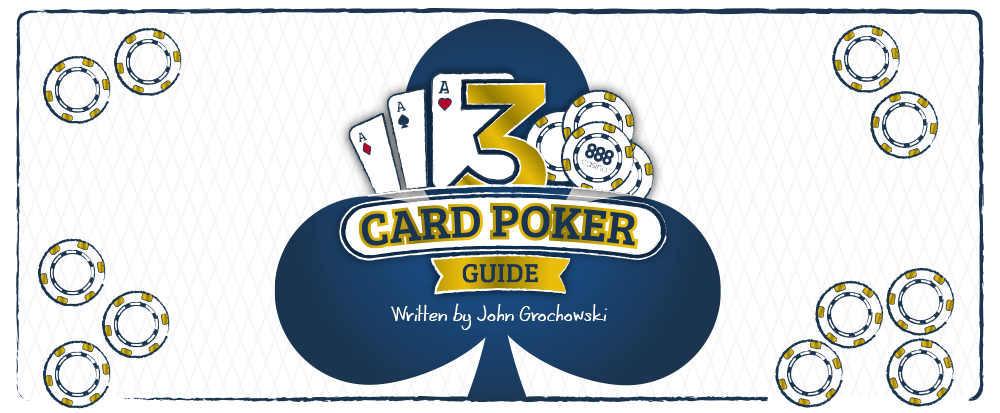
HOW TO PLAY 3 CARD POKER
An initial trial run in Las Vegas brought mixed results, but Three Card Poker then broke through as a popular favorite in the U.S. state of Mississippi. Today, Three Card Poker is a standard offering in live casinos and online casinos alike.
There are several reasons players like Three Card Poker:
- It’s easy to play.
- It has a moderate house edge that gives players a shot to win.
- It has two ways to play, and you can choose a wager with frequent payoffs, a wager on which you can win up to 40 times your bet, or make both bets.
- You can improve your results through a simple, easy to learn basic strategy.
In this chapter, you’ll learn the basics of how to play Three Card Poker.
THREE CARD POKER RULES
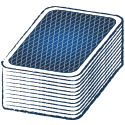
EQUIPMENT
Three Card Poker is played with a single deck of cards, shuffled for every hand. That’s true regardless of whether you’re playing in a live casino or online casino. In live casinos, the shuffling usually is done with an automatic shuffling machine. Standard blackjack-sized, seven-player tables are used in live casinos.
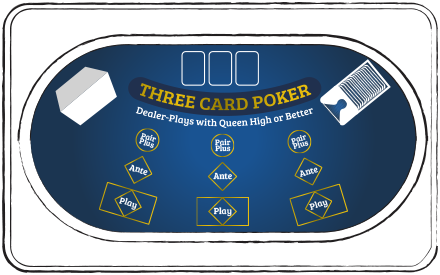
The table layout includes:
- The Three Card Poker logo
- Three card-shaped spaces in front of the dealer to place his cards.
- A circular betting spot marked “Pair Plus.”
- A diamond-shaped betting spot marked “Ante”
- A card-shaped betting spot marked “Play.”
- Pay tables for the Pair Plus bet and for ante bonus payoffs
- A brief explanation of three card poker rules.
One corner of the table next to the dealer will have a placard that tells you the minimum and maximum bet. If it says “Minimum ante: $5. Minimum Pair Plus bet: $5. Maximum $100,” for instance, your initial wagers may not be less than $5 or more than $100 on either option.
RANKING OF HANDS
Three Card Poker is based on stud poker, but odds are different when hands consist of three cards. Because the odds are different, the hand rankings are slightly different than Texas Hold'Em Poker game. In Three Card Poker, straights are rarer than flushes and outrank them. In five-card games, flushes outrank straights.
That leaves the following ranking of hands in Three Card Poker:
- Straight flush
- Three of a kind
- Straight
- Flush
- Pair
- High card
There is no such thing as a full house in Three Card Poker, nor, of course, can you get four of a kind.
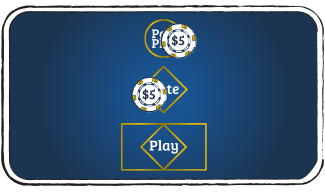
PROCEDURES
All Three Card Poker tables offer two basic ways to play: Ante-play and Pair Plus. Some tables also offer optional side bets. This guide will explore those in Chapter Four: Three Card Poker Options. You may choose whether to play ante-play, Pair Plus or both.
To play ante-play, you must start by placing a wager in the triangular ante space. To play Pair Plus, you must start by placing a wager in the circular Pair Plus space. The dealer then deals each player and himself three cards, face down. After all cards have been dealt, you may look at your cards.
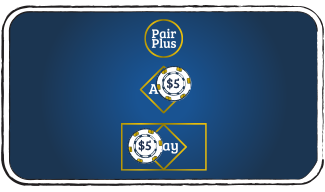
If you are only playing Pair Plus, you need do nothing else. There is no additional wager or decision to make. If you are playing ante-play, you must decide whether to play or fold. If you play, you must make a play bet equal to your ante. The bet cannot be either larger or smaller than the ante.
They must be equal size. If you make the bet, or if you are playing Pair Plus and have a winner, place the cards face down next to your bet. If you do not make the play bet and you do not have a Pair Plus winner, place the cards in front of your bets to signal the dealer you are folding.
SETTLING ANTE-PLAY WAGERS
If you’ve seen your cards and fold, the dealer takes your ante and clears away your cards. Once all players have decided whether to play or fold, the dealer turns his cards face up. If the dealer’s hand is Queen-high or better, the dealer plays. That means ante and play bets all are in action. In order to win, your hand must outrank the dealers. If you win, you are paid even money on both ante and play wagers. If you lose, the dealer takes both bets. If the dealer’s hand is Jack-high or lower, the dealer does not play. In that situation, your hand does not have to beat the dealer. Antes are paid at even money. Play bets are not in action, and the players keep them. If the hands are exact ties, the hand is a push. No payoffs are made, but the player keeps ante and play bets.
Here are a few examples of how the hand could play out on ante-play wagers:
| Dealer hand | Player hand | Result |
| ♦Q ♠3 ♥2 Queen-3-2 of different suits | ♦K ♠8 ♥6 King-8-6 of different suits |
Dealer qualifies; player has higher ranking hand and wins even money on both ante and play bet |
| ♦J ♠10 ♥8 Jack-10-8 of different suits | ♦9 ♠7 ♥3 9-7-3 of different suits |
Dealer does not qualify; player wins even money on ante and keeps play bet |
| ♦2 ♠2 ♥3 2-2-3 of different suits |
♦A ♠K ♥5 Ace-King-5 of different suits | Dealer qualifies and has higher ranking hand, so takes player’s ante and play bet |
| ♦2 ♠2 ♥3 2-2-3 of different suits |
♥J ♥9 ♥5 Jack, 9 and 5 of hearts |
Dealer qualifies and player flush outranks dealer pair, so player wins even money on both ante and play bet |
THE ANTE BONUS
Those who make the ante-play combination also have a chance at an ante bonus. You do not have to beat the dealer to win the ante bonus. It is paid anytime your three-card hand is on a pay table. The most common ante bonus payoffs are 5-1 on straight flushes, 4-1 on three of a kind and 1-1 on straights. There are other ante bonus pay tables, and those affect the house edge on the game. For details, see Chapter 3-2, Ante-Play Odds and Strategies.
SETTLING PAIR PLUS WAGERS
You do not have to beat the dealer to win a Pair Plus bet. Any hand of a pair or better wins – that’s where the Pair Plus name comes from. There are many different Pair Plus pay tables.
Here is the most common:
| Hand type | Example | Payoff |
| Straight flush | ♦10 ♦9 ♦8 10-9-8, all in diamonds |
40-1 |
| Three of a kind | ♣7 ♠7 ♥7 7 of clubs, 7 of spades, 7 of hearts |
30-1 |
| Straight | ♦10 ♥9 ♣8 10 of diamonds, 9 of hearts, 8 of clubs |
6-1 |
| Flush | ♥K ♥J ♥3 King of hearts, Jack or hearts, 3 of hearts |
3-1 |
| Pair | ♠2 ♥2 ♣Q 2 of spades, 2 of hearts, Queen of clubs |
1-1 |
For other pay tables and a discussion of the house edge, see Chapter 3-1. Pair Plus Odds If you have a Pair Plus winner, place the cards face down next to your bet. When the dealer turns cards face up after all players see their cards and ante-play players have bet or folded, he will pay you if you have a winner.
KEY TAKEAWAYS
- There are two basic ways to play Three Card Poker: ante-play and Pair Plus.
- Two win in ante-play if the dealer has a Queen or better, your hand must beat the dealer.
- To win in Pair Plus, you do not have to beat the dealer, but your hand must have a pair or better.

QUIZ
- In the ante-play option, if you ante $5, what’s the most you can wager on the play bet?
- If you ante $10, wager $10 on the play bet and have a straight while the dealer has Jack-10-3 of mixed suits, how much do you win?
- If you ante $10, wager $10 on the play bet and have a straight while the dealer has Queen-10-3 of mixed suits, how much do you win?
- If you have a pair of 6s and the dealer has three 10s, what happens to your Pair Plus bet?
- On the most common Pair Plus pay table, what’s the most a $5 bettor can win?
QUIZ ANSWERS
- In the ante-play option, if you ante $5, the most you can wager on the play bet is $5. The play bet must be equal to the ante
- If you ante $10, wager $10 on the play bet and have a straight while the dealer has Jack-10-3 of mixed suits, you win $10 on your ante. Your play bet is just returned to you because the dealer does not play with a hand of less than Queen high.
- If you ante $10, wager $10 on the play bet and have a straight while the dealer has Queen-10-3, you win $20 -- $10 on your ante and $10 on play when you beat a dealer hand that is Queen high or better.
- If you have a pair of 6s and the dealer has three 10s, you win your Pair Plus bet. You do not have to beat the dealer to win at Pair Plus.
- On the most common Pair Plus pay table, the most a $5 bettor can win is $200 for a 40-1 payoff on a straight flush. You would also keep your $5 bet.

